Best Intraday Trading strategies
The best Forex intraday strategies are:
-
1
Scalping with Bollinger Bands (BB) - trading potential price breakouts or reversals quickly using the BB indicator
-
2
Breakout Trading - identifying significant support and resistance levels and taking advantage of price movements when the price breaks through these levels
-
3
Moving Average Crossover (Using EMA 13 and 26) - trading possible shift in market sentiments as identified by the interaction of moving averages
-
4
Pivot Points - using significant support and resistance levels in the market as potential entry and exit points for intraday trading
-
5
Price Action Trading - studying the price movement of a currency pair to make trading decisions based on observed price patterns
Intraday trading, with its fast-paced nature and potential for quick profits, has captivated the attention of traders in the financial markets. To navigate this dynamic realm successfully, it is crucial to employ effective Forex trading strategies. These strategies are specifically designed to capitalize on short-term price movements and maximize trading opportunities within a single trading day. In this article, the experts at TU will delve into the top intraday trading strategies, providing valuable insights and practical tips to help you make informed decisions, identify entry and exit points, and optimize your profits in the fast-paced world of intraday trading.
What is intraday trading?
Intraday trading, or day trading, involves the buying and selling of securities within a single trading day. It revolves around capturing short-term price movements and exploiting market fluctuations. Here are the key points on how to get started in intraday trading:
Key points about intraday trading
Time sensitivity and analysis:
Intraday trading centers on monitoring real-time charts, indicators, and patterns to identify favorable entry and exit points for trades. Traders rely on shorter time frames, such as one-minute, five-minute, 15-minute, or 60-minute charts, enabling them to make swift decisions based on short-term price fluctuations.
Diverse trading strategies:
Intraday traders employ various strategies tailored to different market conditions and price movements. These strategies may include scalping, range trading, news-based trading, or high-frequency trading. Each strategy aims to optimize profits based on specific market scenarios, providing traders with flexibility and adaptability.
Quick decision-making and time management:
Due to the nature of intraday trading, traders must be attentive and make rapid decisions within the limited timeframe. Tools like volume weighted average price (VWAP) orders can enhance trade execution efficiency, enabling traders to seize opportunities effectively.
Effective risk management:
Managing risk is crucial in intraday trading. Traders commonly employ stop-loss orders to mitigate potential losses and should establish clear profit and loss limits. Understanding risk-reward ratios and implementing risk management strategies are essential to protect capital and ensure sustainable trading practices.
Profit potential and market understanding:
MWhile intraday trading can yield profits for experienced traders with market expertise, it is important to acknowledge the inherent risks associated with market volatility. Beginners should approach intraday trading cautiously, ensuring they possess a solid understanding of market analysis techniques, risk management strategies, and the ability to interpret trends, patterns, and indicators.
Top 6 intraday trading strategies
When it comes to Forex intraday trading, employing the right strategies can greatly enhance your chances of success. In this section, the experts at TU will explore six top-notch Forex day trading strategies that experienced traders employ. These strategies involve various techniques, including capitalizing on small price movements, identifying key levels, utilizing moving averages, leveraging pivot points, and analyzing price action patterns. By understanding these strategies and their respective entry and exit points, you can make informed decisions and maximize your profits.
Scalping with Bollinger Bands
Scalping is a popular intraday strategy where traders focus on making quick profits from multiple trades within a day. A commonly used tool in this strategy is Bollinger Bands, which helps identify price volatility. Traders keep a close eye on the market, looking for opportunities to enter and exit rapidly during short-term price fluctuations. By observing the upper and lower Bollinger Bands, traders can gauge potential price breakouts or reversals, allowing them to seize profitable trading opportunities.
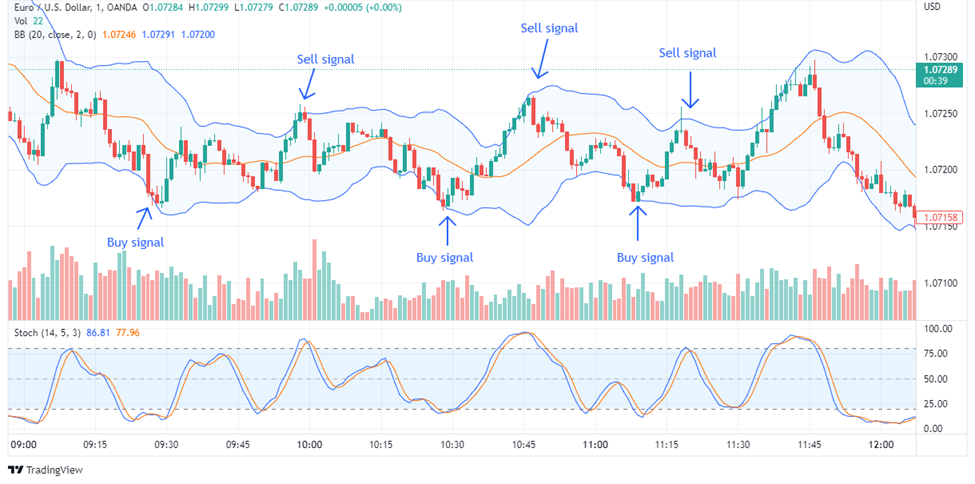
Scalping with Bollinger Bands Strategy
Breakout Trading
Breakout trading involves identifying significant support and resistance levels and taking advantage of price movements when the price breaks through these levels. Traders employing this strategy aim to capture substantial price movements that often occur after a breakout. By carefully analyzing historical price data, traders can pinpoint key levels where the market is likely to experience a breakout. Once a breakout occurs, traders can swiftly enter a trade, expecting to profit from the subsequent price momentum.
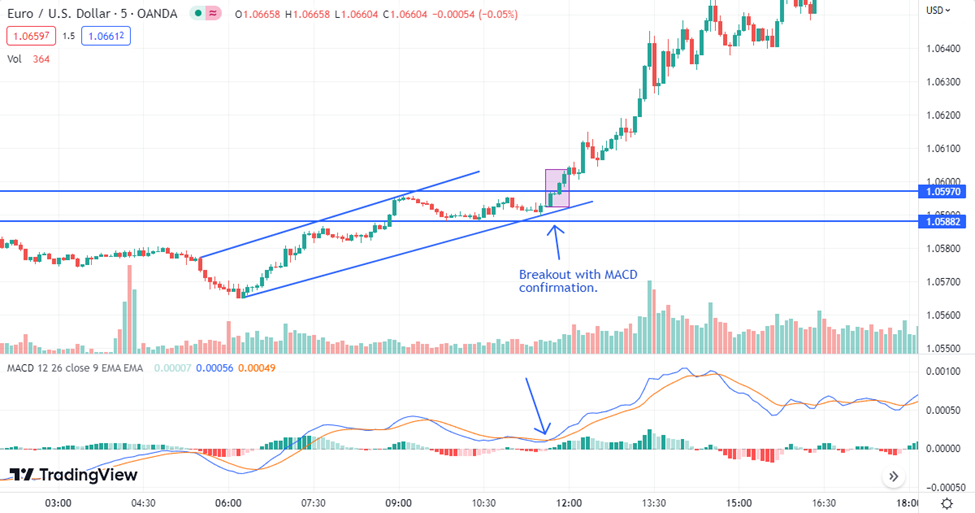
Breakout Trading Strategy
Moving Average Crossover (Using EMA 13 and 26)
The moving average crossover strategy utilizes two moving averages of different lengths to generate trading signals. By plotting exponential moving averages (EMA) with periods of 13 and 26 on a price chart, traders can identify potential trend changes. When the shorter-term moving average crosses above or below the longer-term moving average, it indicates a possible shift in market sentiment. Traders can use these crossovers as signals to enter or exit trades, aligning their positions with the anticipated trend direction.
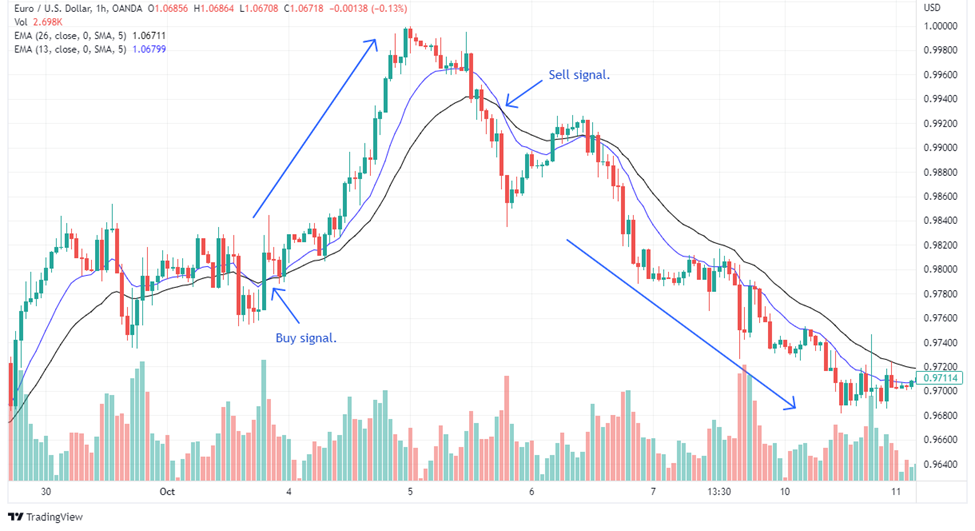
Moving Average Crossover Strategy
Pivot Points
Pivot points serve as valuable indicators to determine significant support and resistance levels in the market. Traders use these levels as potential entry and exit points for intraday trading. Pivot points can be calculated using various methods, and traders often customize them based on their preferred timeframes and trading objectives. By identifying pivot points, traders gain insights into price levels where the market may reverse or experience increased buying or selling pressure, enabling them to plan their trades more effectively.
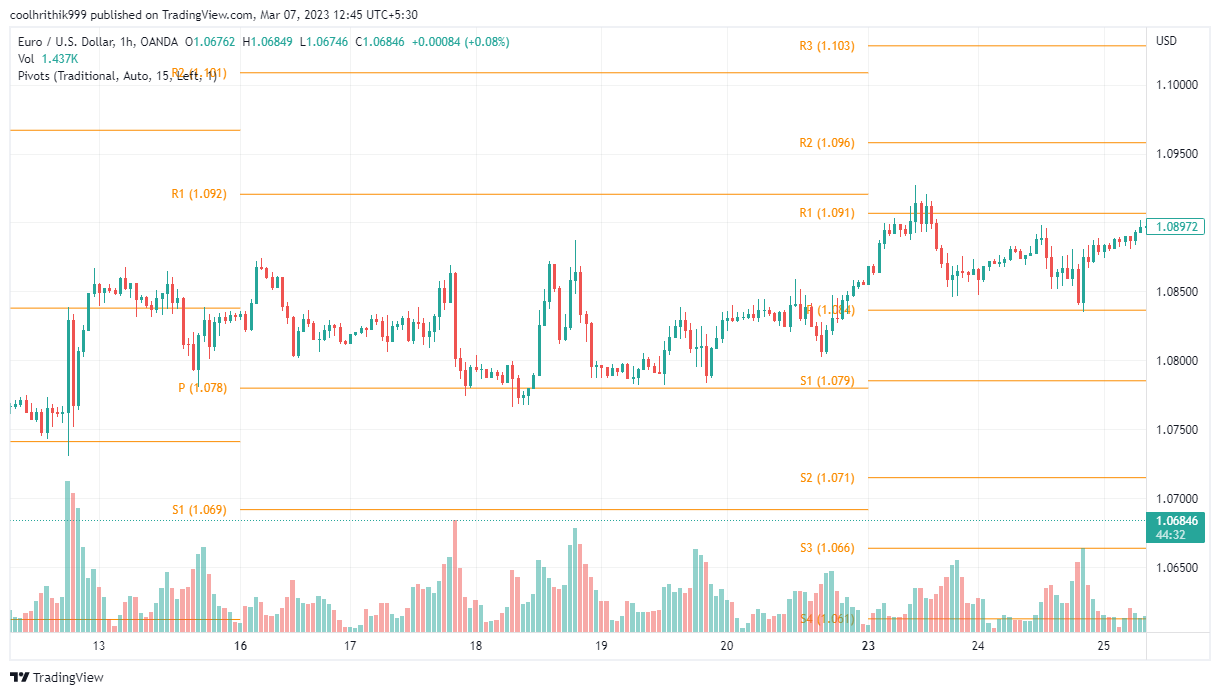
Pivot Points Strategy
Price Action Strategy
The price action strategy involves studying the price movement of a currency pair to make trading decisions based on observed price patterns. Traders utilizing this strategy focus on identifying trends, support and resistance levels, and candlestick patterns to forecast future price movements. By waiting for a price pattern to form and then confirming its validity, traders can enter trades in anticipation of the price continuing in the same direction. Various candlestick patterns, such as bullish-engulfing, doji, or morning star, can offer valuable signals for initiating trades based on their respective patterns.
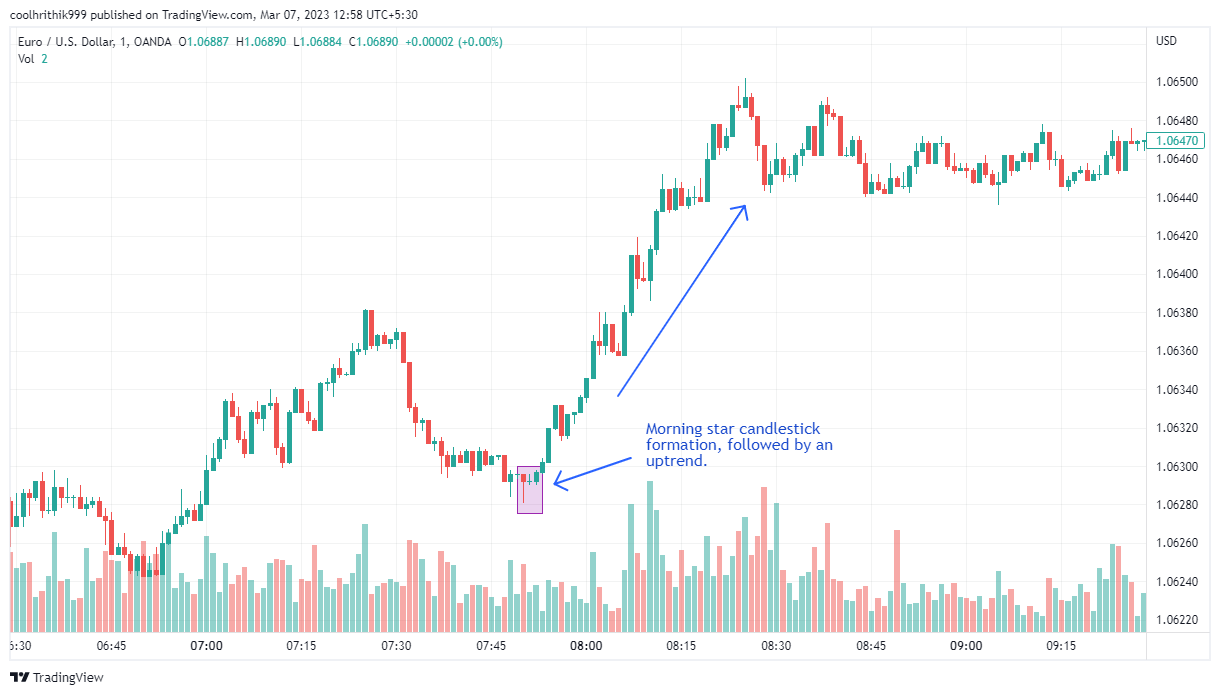
Price Action Strategy
Pros and cons of intraday trading
👍 Pros
•
Leverage and margin trading:
Intraday traders can leverage their trading capital by using margin accounts. This allows them to control larger positions with a smaller investment, potentially amplifying their profits if the trades go in their favor
•
Opportunity for regular income:
Successful intraday traders who consistently make profitable trades can establish a regular source of income. They have the flexibility to withdraw profits on a daily basis, providing a potential stream of income to meet daily expenses
•
No overnight risk:
Intraday traders close all their positions before the market closes, eliminating the exposure to overnight risks. This means they are not affected by unexpected events or news that may occur outside of the trading hours, reducing the potential impact on their trades
•
Ability to capture quick profits:
Intraday trading allows traders to take advantage of short-term price fluctuations and seize quick profit opportunities. They can enter and exit trades within the same trading session, potentially making multiple profits in a day
👎 Cons
•
Deceptive market movements:
The market has a tendency to deceive traders, especially in the realm of intraday trading. It is not uncommon to experience a few successful trades that can instill a false sense of confidence, only to be followed by significant capital losses due to impulsive or aggressive trading decisions. It is crucial to remain cautious and avoid being lured into reckless trading based on short-term gains
•
Discipline and risk management:
Intraday trading requires a high level of discipline and strict adherence to risk management principles. Even a momentary lapse in discipline or risk control can have detrimental effects on trading performance. Traders must consistently implement their trading plans, manage emotions effectively, and closely monitor their risk exposure to mitigate potential losses
•
Demanding effort and skill set:
Intraday trading demands a considerable amount of effort and a diverse skill set. Traders need to develop proficiency in market analysis, chart interpretation, and trading execution. Playing multiple roles and maintaining consistent performance on a daily basis can be mentally and emotionally challenging. It requires continuous learning, practice, and dedication to refine trading skills and stay ahead of market trends
Does intraday trading work? Is it profitable?
Yes, intraday trading can indeed be profitable when combined with the right trading strategy. The profitability of intraday trading largely depends on various factors, including the trader's skill, knowledge, strategy, and market conditions. And while it can offer lucrative opportunities, it also carries risks that need to be carefully managed.
To determine whether intraday trading is profitable, traders must develop and implement a well-defined trading plan based on thorough research and analysis. It is essential to identify a quantified strategy that has been tested and proven to have an edge in the market. Backtesting historical data and conducting thorough analysis can help traders assess the potential profitability of their chosen strategy.
Successful intraday traders often possess a deep understanding of technical analysis, chart patterns, and market indicators. They leverage this knowledge to identify favorable entry and exit points, manage risk effectively, and capitalize on short-term price movements. Additionally, traders must stay updated on market news and economic events that can impact currency movements, enabling them to make informed trading decisions.
Tips to keep in mind in intraday trading
Forex intraday trading can be a dynamic and potentially profitable endeavor if approached with the right mindset and strategies. Here are some expert tips for Forex to keep in mind when engaging in intraday trading:
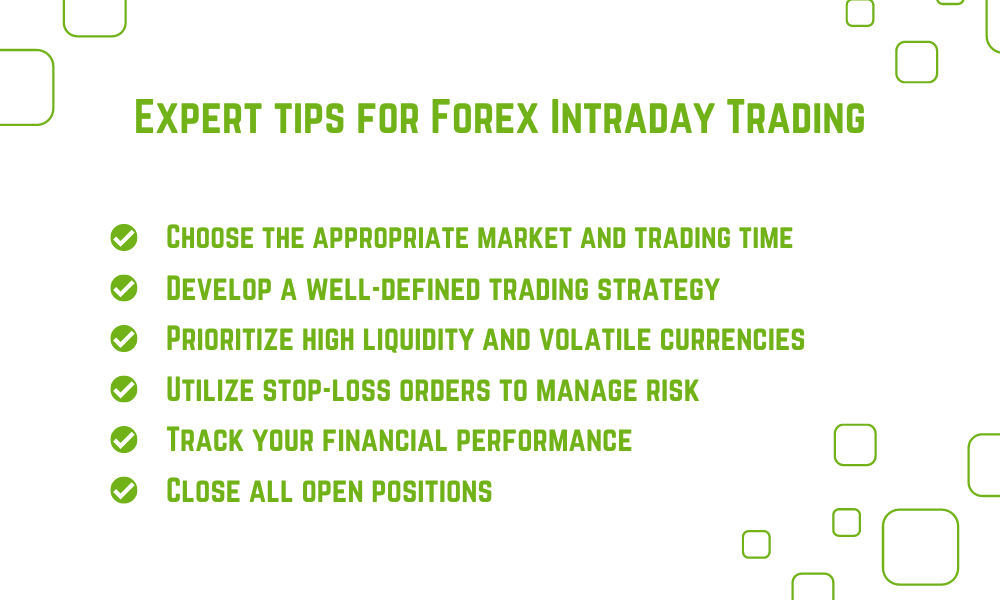
Choose the appropriate market and trading time:
Consider your available capital and select a market that aligns with your budget. For example, the currency market typically requires less capital compared to stocks. Additionally, establish a routine and trade during a specific time that suits your trading strategy and availability. This consistency will help you better understand market patterns and optimize your trading decisions
Develop a well-defined trading strategy:
As you gain experience, focus on formulating a robust intraday trading strategy that suits your trading style and risk tolerance. It is crucial to find a strategy that resonates with you and consistently implement it to increase the potential for profitable trades. Continually refine and adapt your strategy as market conditions evolve
Prioritize high liquidity and volatile currencies:
When selecting currencies for intraday trading, prioritize those with high liquidity and medium to high volatility. These Forex currencies tend to offer more trading opportunities and potential price movements that can be capitalized on. Conduct thorough research and utilize technical analysis tools to identify stocks with favorable liquidity and volatility characteristics
Utilize stop-loss orders to manage risk:
Implementing stop-loss orders is a vital risk management technique in intraday trading. Set predefined stop-loss levels to automatically sell shares if the price falls below a certain limit. This helps limit potential losses and ensures disciplined risk management
Track your financial performance:
It is crucial to keep a close eye on your financial gains and losses. Regularly review and assess your trading performance to identify areas for improvement and adjust your strategies accordingly. Maintain accurate records of your trades and analyze them to refine your approach over time
Close all open positions:
At the end of each trading session, ensure that all your open positions are closed. Leaving positions open overnight can expose you to increased risk due to unexpected market movements or news events. By closing positions at the end of the day, you mitigate the potential for unwanted surprises and start each trading session with a clean slate
Best time frame for intraday trading
Intraday trading requires careful consideration of time frames to effectively analyze price movements and make timely trading decisions. A popular approach among traders is to utilize multiple timeframe analysis, commonly employing a ratio of 1:4 or 1:6.
When using a 1:4 ratio, traders typically choose a longer time frame chart such as the four-hour chart as their primary reference. This higher timeframe provides a broader perspective on market trends and significant price levels. It allows traders to identify key support and resistance areas, major trends, and overall market sentiment.
In contrast, the lower timeframe, often a one-hour chart, is used for precise entry and exit timing. By observing the shorter timeframe, traders can closely monitor price fluctuations, spot intraday patterns, and fine-tune their trading decisions accordingly.
The combination of these two time frames enables traders to gain insights into both the broader market context and the more immediate price dynamics. It provides a balanced approach to intraday trading, ensuring that traders do not solely focus on short-term fluctuations while still considering the overarching market trends.
However, it's important to note that the choice of timeframes may vary depending on individual trading preferences, the asset being traded, and market conditions. Some traders may prefer different ratios or utilize additional timeframes, such as a 15-minute chart for precise intraday entries.
Best Forex brokers for intraday trading 2024


FAQs
What is the most powerful strategy for intraday trading?
The most powerful strategy for intraday trading can vary depending on individual preferences and market conditions. It is important to develop a well-defined trading strategy that aligns with your trading style and risk tolerance.
What is the most successful strategy in Forex trading?
The most successful strategy in Forex trading can vary among traders. It depends on factors such as market conditions, individual trading preferences, and risk management. It is essential to develop a strategy that suits your trading style and consistently implement it.
What is the 5 3 1 trading strategy?
The 5 3 1 trading strategy involves choosing five currency pairs, developing three strategies with multiple combinations of trading styles, technical indicators, and risk management measures, and selecting the most suitable time for trading.
Is intraday trading profitable in Forex?
Intraday trading can be profitable in Forex, but it requires a solid trading strategy, disciplined execution, risk management, and continuous learning.
Glossary for novice traders
-
1
HFX
HFX trading likely refers to high-frequency forex trading, where automated algorithms execute a large number of trades at extremely high speeds.
-
2
Index
Index in trading is the measure of the performance of a group of stocks, which can include the assets and securities in it.
-
3
Time Management
Time management is the coordination of tasks and activities to maximize the effectiveness of an individual's efforts.
-
4
Forex Risk Management
Risk management in Forex involves strategies and techniques used by traders to minimize potential losses while trading currencies, such as setting stop-loss orders and position sizing, to protect their capital from adverse market movements.
-
5
Leverage
Forex leverage is a tool enabling traders to control larger positions with a relatively small amount of capital, amplifying potential profits and losses based on the chosen leverage ratio.
Team that worked on the article
Chinmay Soni is a financial analyst with more than 5 years of experience in working with stocks, Forex, derivatives, and other assets. As a founder of a boutique research firm and an active researcher, he covers various industries and fields, providing insights backed by statistical data. He is also an educator in the field of finance and technology.
As an author for Traders Union, he contributes his deep analytical insights on various topics, taking into account various aspects.
Dr. BJ Johnson is a PhD in English Language and an editor with over 15 years of experience. He earned his degree in English Language in the U.S and the UK. In 2020, Dr. Johnson joined the Traders Union team. Since then, he has created over 100 exclusive articles and edited over 300 articles of other authors.
Mirjan Hipolito is a journalist and news editor at Traders Union. She is an expert crypto writer with five years of experience in the financial markets. Her specialties are daily market news, price predictions, and Initial Coin Offerings (ICO).











